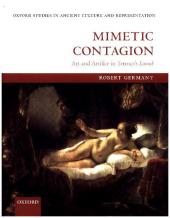 Neuerscheinungen 2016Stand: 2020-02-01 |
Schnellsuche
ISBN/Stichwort/Autor
|
Herderstraße 10
10625 Berlin
Tel.: 030 315 714 16
Fax 030 315 714 14
info@buchspektrum.de |

Robert Germany
Mimetic Contagion
Art and Artifice in Terence´s Eunuch
2016. 224 S. 255 mm
Verlag/Jahr: OXFORD UNIVERSITY PRESS 2016
ISBN: 0-19-873873-0 (0198738730)
Neue ISBN: 978-0-19-873873-2 (9780198738732)
Preis und Lieferzeit: Bitte klicken
This volume considers the phenomenon of mimetic contagion, whereby works of art draw viewers into direct imitation of themselves, and how it operates within specific historical contexts. Terence´s Eunuch is used as a case study, situating the motif within the peculiarities of mid-second-century BC Rome and its anxieties about the power of art.
When we are confronted with a work of art, what is its effect on us? In contrast to post-Enlightenment conceptions, which tend to restrict themselves to aesthetic or discursive responses, the ancient Greeks and Romans often conceived works of art as having a more dynamic effect on their viewers, inspiring them to direct imitation of what they saw represented. This notion of ´mimetic contagion´ was a persistent and widespread mode of framing response to art across the
ancient world, discernible in both popular and elevated cultural forms, yet deployed differently in various historical contexts; it is only under the specificity of a particular cultural moment´s concerns that it becomes most useful as a lens for understanding how that culture is attempting to
negotiate the problems of representation.
After framing the phenomenon in terms general enough to be applicable across many periods, literary genres, and artistic media, this volume takes a particular literary work, Terence´s Eunuch, as a starting point, both as a vivid example of this extensive pattern, and as a case study situating use of the motif within the peculiarities of a particular historical moment, in this case mid-second-century BC Rome and its anxieties about the power of art. One of the features of mimetic
contagion frequently noted in this study is its capacity to render the operation of a particular work of art an emblem for the effect of representation more generally, and this is certainly the case in the Eunuch, whereby the painting at the centre of the play functions as a metatheatrical figure for the dynamics
of mimesis throughout, illustrating how the concept may function as the key to a particular literary work. Although mimetic contagion is only one available Greco-Roman strategy for understanding the power of art, by offering an extended reading of a single work of literature through this lens, this volume demonstrates what ramifications closer attention to it might have for modern readers and literary criticism.
This impeccably produced book is unpretentiously erudite; as the saying goes, much more than the sum of its (very many, ancient and modern) parts, impressively documented and arranged: literary-philological analysis and performance criticism, art-historical and anthropological inquiry, sociocultural and intellectual history. Germany regularly deploys critical theory pedagogically judiciously, painlessly introducing uninitiated readers to Benjamin, Foucault, Frazer, Gell, and Irigaray, to name some. Ultimately, Germany´s sophisticated and dense analysis, masterfully delivered in clear, serene prose is a pleasure to read. All along, the book is very polemical-indeed fundamentally polemical-though about as honestly and pertinently as polemics can be. ... This book, a giant step forward in Terentian scholarship, is in every respect his worthy legacy Goran Vidovic, Bryn Mawr Classical Review


